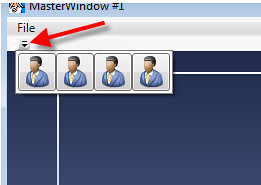I have a WPF window that has a ToolBar. I have a collection of objects in my VM that I'm binding to. They appear as buttons but they always get pushed to the expanded drop down part of the ToolBar. How do I make those buttons appear in the standard part of the ToolBar?
I have the following XAML:
<ToolBarTray Grid.Row="1">
<ToolBar ItemsSource="{Binding Path=MyList}" >
<ToolBar.ItemTemplate>
<DataTemplate >
<Button ToolTip="{Binding ButtonName}"
Command="{Binding Path=ButtonCommand}" >
<Button.Content>
<Image Width="32" Height="32" Source="{Binding ImageSource}"/>
</Button.Content>
</Button>
</DataTemplate>
</ToolBar.ItemTemplate>
</ToolBar>
</ToolBarTray>
I have the following C#:
public List<MyClass> MyList
{
get
{
return new List<MyClass>
{
new MyClass{ButtonName="Button1",ImageSource=@"C:\Projects\WpfApplication2\WpfApplication2\Employee.png"},
new MyClass{ButtonName="Button2",ImageSource=@"C:\Projects\WpfApplication2\WpfApplication2\Employee.png"},
new MyClass{ButtonName="Button3",ImageSource=@"C:\Projects\WpfApplication2\WpfApplication2\Employee.png"},
new MyClass{ButtonName="Button4",ImageSource=@"C:\Projects\WpfApplication2\WpfApplication2\Employee.png"},
};
}
}
This is the visual result:

There is a bug in the toolbar, if you re-size the window, the problem goes away.
The solution is using another control, like:
Check out this thread for more info
To add to Eduardo's, I had to slightly tweak this since my item source was getting populated asynchronously, some time after the initial UI is displayed:
This was enough to catch all edge cases and have the overflow properly happen as needed after population of the items.
You can also set the height of the toolbar in the xaml to a reasonable value which has worked for me.